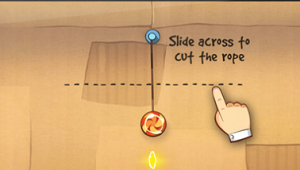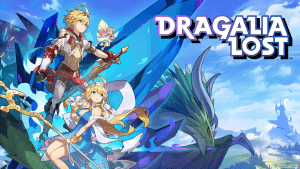Rules of the Road: How the best F2P games ensure their big spenders don’t get stuck in traffic
Imagine you’re in the middle of a long road trip with your family. The drive starts off at a fairly speedy pace of 75 mph. Everything is going great; you’re on time, you’re happy, and each member of your family is gripped to their respective phones.
A few hours in, you start noticing the traffic on the road is becoming dense. As a result, the pace of your car begins to slow. In reality, you know this isn’t a good sign: years of driving has taught you hours’ worth of queuing lies ahead with little chance of escape, even though you’re praying you’re wrong.
All of a sudden, someone cuts you off. You slam on the breaks just in time and, fortunately, you avoid a crash. You look up in the rearview mirror to make sure your kids are ok – which they are. However, they’re all now looking up from their phones at the density of cars on the road, and everyone in the car, like you, is dreading what’s to come.
Now, if you hadn’t already guessed, it’s my belief that such events accurately mirror the experience that every one of us at some points goes through with a mid-to-hardcore free-to-play game. At the beginning of such games, every player knows they’re going to get stuck in traffic – caught up in the lines of cars and happy to sit in the grind for free rather than pay the fee required to jump ahead.
It’s up to developers do decide just how they’re going to get the paying players out of there. Should they build in a carpool lane? A toll road? Install Google Maps with traffic updates? Throw in a helicopter?
Carpool Lane
Let’s start by looking at an example of building in a carpool lane. When it comes to free to play games, these are the equivalent of a monthly subscription offer – a model that’s become rather popular in the last two years.
In practice, they give the player a medium-sized lump sum of currency upon initial purchase, followed by a small (but nevertheless meaningful) amount each day for the next 30 days. Ultimately, the total amount over the 30 days is a lot more than one-time purchase for the same amount.
Price range: Between $2.99 and $9.99
In the example below, Lineage 2: Revolution offers some Adena (gold) subscriptions with five times as much currency on day one as a player receives every other day of the month.
If a player was to try and buy this much Adena at once, they’d have to pay three times as much, or maybe even more.
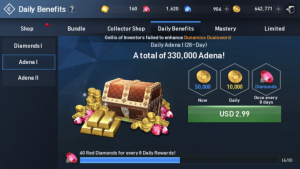
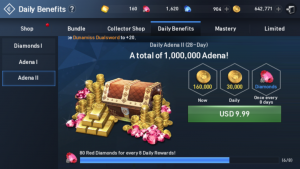
We took a brief survey of players from our Lineage 2 Community, and found that 17 out of 20 players who spent money on this game had bought these subscriptions.
In reality, however, the daily rewards are very small. With one side quest that lasts five minutes, a player can earn 21,000 gold. Only five side quests can be performed daily, but still, the daily rewards are small. It’s not hard to understand how this $9.99 subscription only provides slight relief from the traffic.
It’s important that your subscription offers can scale as a player progresses to late game. In the examples above with Lineage, those offers quickly become irrelevant when a player reaches level 100 of 180. However, Lineage could easily offer higher priced subscriptions that are relevant to later levels.
Toll road
In truth, a toll road that diverts them away from the mass of traffic isn’t all too different from a carpool lane. It’s essentially the next tier in the same approach – a monthly subscription.
Price range: $19.99 to $29.99
It’s not often that I’ll see subscriptions for more than $29.99, because the audience that buys them are most likely budget players. Subscriptions certainly provide mild relief from the traffic – even driving 10 mph faster than the rest of the cars on the road, any driver knows you’re party to a few solid endorphins. However, it’s once again key to make sure you consider how these subscriptions scale to the latter stages of the game.
Google Maps
Has Google Maps ever offered you a shortcut, but in reality it felt like it took just as long to get to your destination as if you’d stuck to your original path?
It’s a feeling that sucks and makes every future trip feel like something of a risk. However, as the likes of Google upgrade their software, so such events are becoming rarer and rarer. For every bad turn, shortcuts cuts actually end up paying off, offering you a smarter route that cuts your journey time. It’s at this point that using platforms like Google Maps builds trust with the consumer, and this to me is exactly how Gachas feel.
Price range: $29.99 to $99.99
If I pull my wallet out and take the leap of faith to try my luck on a gacha, and the rewards make me feel like I could’ve just played a few more days to get the same rewards, then I’m very discouraged to try my luck again. Maybe your VIPs will try their luck a few more times, but are unlikely to keep trying if they don’t see a solid result? On the contrary, if players get a favorable result the first time, their first impression of spending will be positive. It’s a feeling that can go a long way.
Personally, I like it when I see games that have limited offers of guaranteed results – preferably, even their most expensive gachas offer favorable results. For example, there’s a rival to the ridiculously successful Clash Royale that has unexpectedly held my attention for far longer than I expected. Star Wars: Force Arena comes complete with gachas that boast some guaranteed results. In this case, I’m more likely to make a purchase because the guaranteed results take any random elements out of the equation.
In the image below, I can buy a package with certain characters having a much higher, guaranteed chance to drop. I love this type of offer because I’m guaranteed to save a lot of time.
The legendary drop rates in this game for free packs that come from winning battles are so low that I’ve never received any legendary items in the two months I’ve been playing. Thus, I know for a fact that making this purchase will put me way ahead of many competitors.
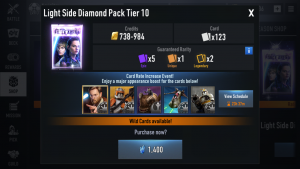
On the other hand, Clash Royale’s special offers aren’t guaranteed to drop the character types that match my deck. This makes the risk a lot higher. Some days, I might be feeling rich and want to take my chances on a gacha, but my conservative nature makes me lean towards the packages in Star Wars: Force Arena with major appearance boosts.
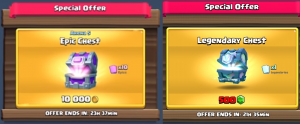
A very engaged, passionate, wealthy audience might go for full risk gachas like in Clash Royale, but the more trust you take out of the equation, the higher conversion rate you’ll have. Consider the great feeling you get when Google Maps says, “Save 25 minutes by this recommended route,” and it actually happens. That’s exactly what a successful gacha feels like.
With gachas, like subscriptions, it’s also important to consider their relevance in late game. Early to mid game players are likely to have a high chance of a good first impression, because they don’t need legendary drops to make significant progress. However, late game players can only progress with legendary drops. As a result, you might have a different format of gacha for them, and it may only appear to those certain higher level players.
Helicopter
Arguably, what every driver wants when ground to a halt in traffic is for someone to pick them up and fly them off at speed into the distance. There’s nothing quite as frustrating as moving a few inches a minute. Players want to fly.
Some developers, like Machine Zone (MZ), put the option to fly front and centre. MZ’s sales are exclusively in the form of bundles that offer an enormous amount of various currency items: speedups, resources, hero XP, VIP, alliance gifts, unique key upgrade items, etc. All of this is offered for a price – usually $99.99. These bundles offer so much, that they often give the player the experience of flying through the game.
In MZ’s monetization strategy, the only option is to fly, because traffic is at a dead stop. After only a few levels, each upgrade takes an enormous time. While level 10 of 25 buildings might only take a few hours, level 11s take half a day. With each new level unlocked, the wait time scales much higher and longer. Believe it or not, some timers even take a few years to complete.
Take a look at the length of speed ups offered in a package from the studio’s most recent game, Final Fantasy XV: A New Empire.
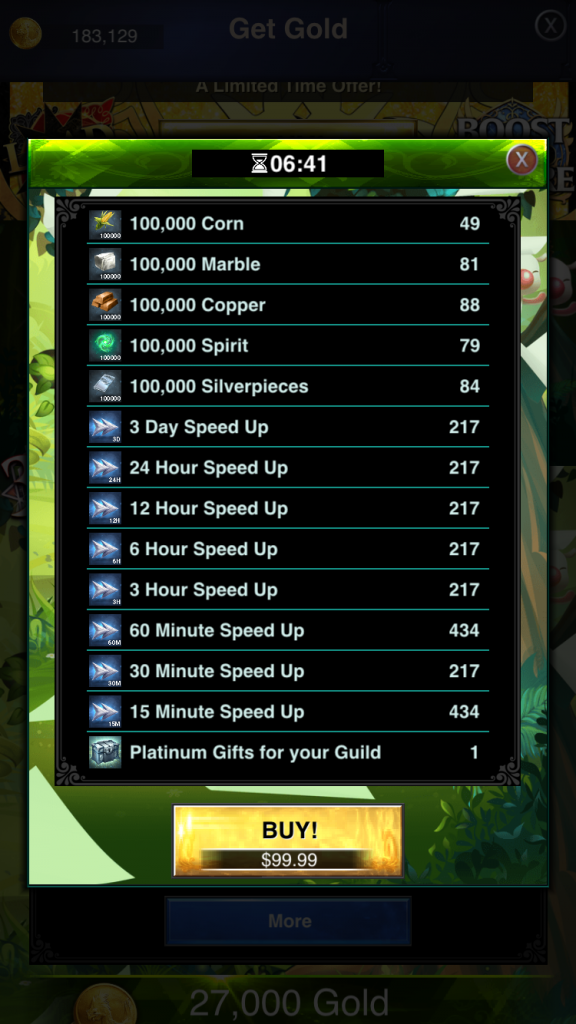
It’s an interesting approach, namely because it’s ‘all or nothing’. Players can’t make any progress using traditional free to play methods in Final Fantasy XV: A New Empire. Assuming equal skill level, it is impossible to compete with those who have spent a few hundred more dollars than you. Dipping back into our analogy, the price of flying ahead with a helicopter ride is high – at a minimum, purchases will be between $49.99 and $99.99.
Most of the time, packs in MZ games give guaranteed results. The Valentine’s Day sale below offers instant upgrades to level 30 for all buildings.
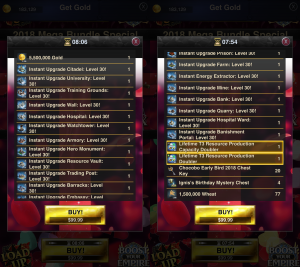
Occasionally, MZ will have sales with hundreds or thousands of gacha chests. When this happens, a VIP player will typically buy a few and let the rest of the population know if the chests have good drop rates or not. So, once again, first impressions are a big deal.
However, I do want to warn you about changing the drop rates after the initial purchase. We’ve seen MZ try to do this in various ways. Players always find out eventually, and it leaves a bad taste in their mouth.
Don’t run out of road!
We’ve covered all the different ways you can help players get out of traffic, but it’s also important to make sure you don’t run out of road, because then you’ll have no traffic left to monetize.
Different games take different approaches to this. For example, in Lineage 2, the first few expansions of the game offer limited additional content that can be quickly maxed with a few hundred dollars. Then, what’s left is a deep meta game of tediously limit breaking gear, rolling for the best stats you can, and experimenting with different builds for PVP – essentially, it’s a PVP-driven end game.
Counter to that is Final Fantasy XV: A New Empire, which never lets any player max the game. When a new feature is released, the first few levels will be attainable with a few hundred dollars; the next few levels can be acquired with a few thousand dollars, but the last few levels will be unattainable for even the largest VIPs.
When MZ is ready to release the next feature, it increases the currency in packs necessary to max the last few levels of the previous feature, at the same time as releasing the next feature.
Conclusion
In short, a developer’s job is to make sure players can dodge traffic however they see fit. If players want to spend money to get them out of the grind, the game should be able to offer them immediate satisfaction and sustained gratification. The trick is to make sure they feel like getting out of traffic is something they couldn’t have achieved in the same manner without spending money – their investment has to feel worthwhile, and there are three key ways to achieve this: –
- High conversion items should have tiers
- Gachas should guarantee drops over time (while scaling cost)
- Sales targeted at VIPs should go all out – make sure you give a large variety of content that allow VIPs to get where they want to go, without restriction
Follow the rules of the road as laid out above, and you can be sure your game will be populated with happy and contented motorists.
About the Author
Chad Kihm is the CEO of App Scrolls, a company that provides game design consulting, community development and management, as well as community marketing services. App Scrolls currently manages communities for Game of War, Final Fantasy XV: A New Empire, Summoner’s War, and Lineage 2: Revolution.




